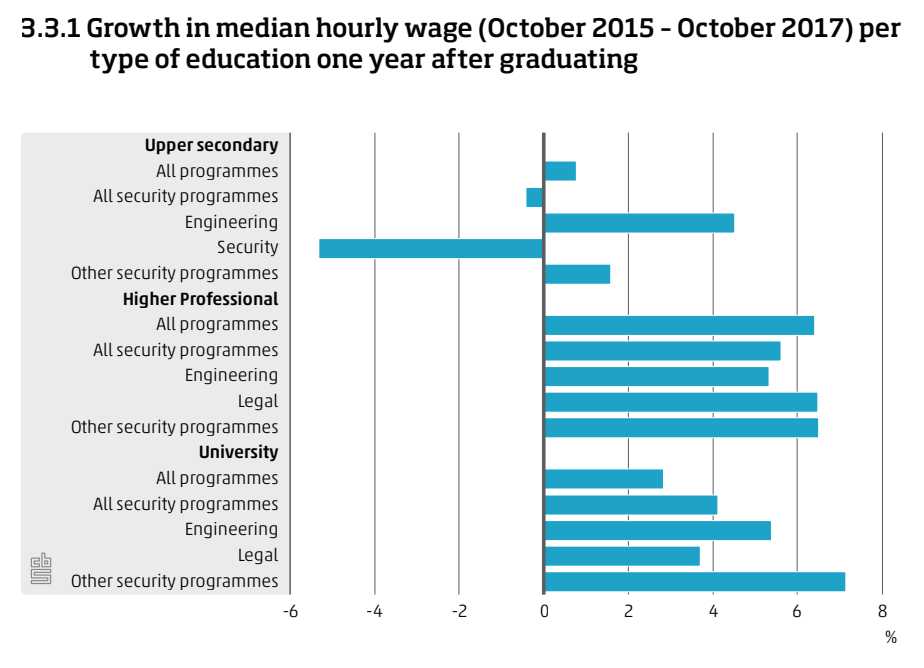- Home >
- Services >
- Access to Knowledge >
- Trend Monitor >
- Domain of Application >
- Trend snippet: More security graduates are finding work, wages vary by province and level of education
Trends in Security Information
The HSD Trendmonitor is designed to provide access to relevant content on various subjects in the safety and security domain, to identify relevant developments and to connect knowledge and organisations. The safety and security domain encompasses a vast number of subjects. Four relevant taxonomies (type of threat or opportunity, victim, source of threat and domain of application) have been constructed in order to visualize all of these subjects. The taxonomies and related category descriptions have been carefully composed according to other taxonomies, European and international standards and our own expertise.
In order to identify safety and security related trends, relevant reports and HSD news articles are continuously scanned, analysed and classified by hand according to the four taxonomies. This results in a wide array of observations, which we call ‘Trend Snippets’. Multiple Trend Snippets combined can provide insights into safety and security trends. The size of the circles shows the relative weight of the topic, the filters can be used to further select the most relevant content for you. If you have an addition, question or remark, drop us a line at info@securitydelta.nl.
visible on larger screens only
Please expand your browser window.
Or enjoy this interactive application on your desktop or laptop.
More security graduates are finding work, wages vary by province and level of education
marginally lower for security related programmes than the overall share. For example,
83 percent of graduates in upper secondary vocational security related programmes of
school year 2015/’16 found work within one year, whereas the share for all upper
secondary vocational programmes in that year was 85 percent. This difference was smaller
for higher professional programmes and was effectively zero for university programmes.
Over time the general trend is that more graduates are finding work. This trend is
particularly pronounced for university graduates from engineering programmes; 72 percent
of the university graduates in security related programmes of school year 2015/’16 found
work immediately and 89 percent within one year. Hourly wages varied per province. Generally, wages seem to be higher than the national median in Noord-Holland and Zuid-Holland. The level of education was however an important determinant of hourly wages per province. Wage growth was positive for all programmes in higher professional and university education.
This section expands on the previous section by considering how successful graduates were on the labour market. We do so by considering how many graduates found work and how much they earned. These topics are discussed in that order in this section. The share of graduates of different programmes who found work after study was marginally lower for security related programmes than the overall share. For example, 83 percent of graduates in upper secondary vocational security related programmes of school year 2015/’16 found work within one year, whereas the share for all upper secondary vocational programmes in that year was 85 percent. This difference was smaller for higher professional programmes and was effectively zero for university programmes. Over time the general trend is that more graduates are finding work. This trend is particularly pronounced for university graduates from engineering programmes; 72 percent of the university graduates in security related programmes of school year 2015/’16 found work immediately and 89 percent within one year. Where graduates from security related programmes found work (in terms of branches) remained predominantly constant over time. Some trends do exist though, for example that the branch ‘information and communication’ has become a relatively more important destination for graduates than ‘public administration and services’ between 2016 and 2018.
Wage growth4) is a particularly interesting indicator because it is related to the functioning of the labour market. Figure 3.3.1 shows wage growth for different types of education one year after graduating. It shows that wage growth was positive for all programmes in higher professional and university education. The overall wage growth for all security programmes in upper secondary vocational education was negative however, as wage growth was negative for some programmes in upper secondary vocational education. Specifically, the wages of graduates of Security education at upper secondary vocational level dropped from circa €12.40 to circa €11.70 between October 2015 and October 2017 for employed persons one year after graduating. Higher professional education generally showed the highest wage growth although wage growth for security graduates was slightly lower than the median for higher professional education. In contrast, for university education, graduates of security programmes benefited from greater wage growth

2.5 Work after study — From all the participants of school year 2015/’16 who ended their upper secondary vocational education in October 2016, 80 percent had a paid job directly upon finishing their education. For the participants in a security related upper secondary vocational programme this was 76 percent. — 29 percent of the participants who found a job after ending their education in a security related programme in school year 2015/’16, found a job in the sector Renting and other business support. Other important sectors were the Wholesale and retail trade (13 percent), Other specialised business services (13 percent) and Public administration and services (10 percent). — The median hourly wages for starters with an upper secondary vocational education in security in 2016 were 11 percent lower than the median for those with any upper secondary vocational education, whereas the hourly wages for starters with a higher professional education in security were 3 percent higher than the median hourly wage. Those with a university education in security earn only 0.4 percent more than the median for those with a university education. — Hourly wages varied per province. Generally, wages seem to be higher than the national median in Noord-Holland and Zuid-Holland. The level of education was however an important determinant of hourly wages per province. For example, those with security education at university level in Zeeland earned appreciably less than the national median but those with higher professional education earned slightly more than the national median.






